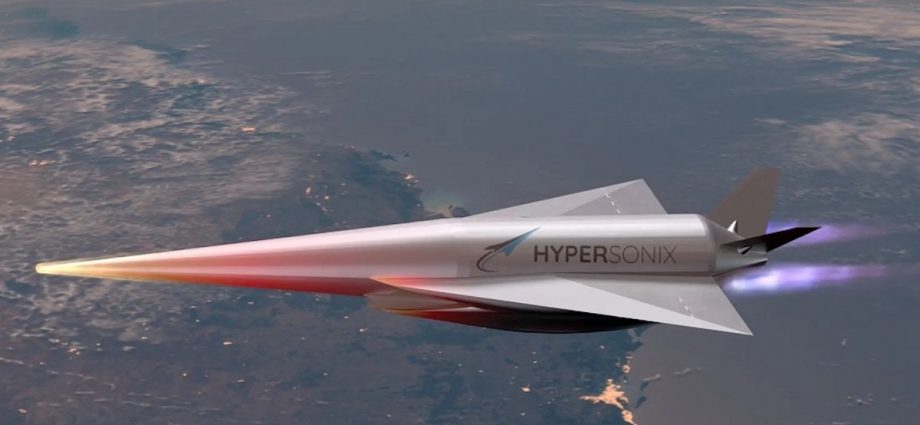The US and Australia have announced plans to develop a hypersonic aircraft, the latest development in the AUKUS allies’ high-tech defense partnership that is fast-transforming the region’s security dynamics.
This week, Defense News reported that the US Department of Defense (DOD) has selected Australia-based aerospace company Hypersonix to develop a high-speed aircraft to test hypersonic technologies.
The report says that the aircraft will support America’s Hypersonic and High-Cadence Airborne Testing Capabilities (HyCAT) program, which aims to enlist the private sector and military users to alleviate strain on government testing facilities.
Defense News mentions commercial companies are forging toward reusable and low-cost launch vehicles, with the HyCAT representing a paradigm shift in hypersonics from weapons to aircraft.
It also says that testing has been a significant roadblock in hypersonic weapons development and that the US plans to increase the pace of weapons tests with one HyCAT test a year as part of the strategy.
Hypersonix’s DART AE aircraft is powered by a hydrogen-powered scramjet that can reach Mach 7 and test high-speed platforms, components, sensors, communications and control systems. It is slated for its first flight in 2024, according to Defense News.
Data from DART AE tests may be used to develop a hypersonic spy plane. In December 2022, Asia Times reported on US plans to develop Project Mayhem, which may be the successor to the vaunted SR-71 spy plane.

The US awarded Virginia-based aerospace firm Leidos a US$334 million price ceiling to develop a “larger class air-breathing hypersonic system capable of executing multiple missions with a standardized payload interface, providing a significant technological advancement and future capability.”
Leidos will work at the Wright-Patterson Air Base in Ohio and other testing sites, with the project expected to be completed by October 2028.
The aircraft, dubbed the SR-72, is envisioned to perform multiple missions including delivering area-effect or unitary payloads or intelligence, surveillance and reconnaissance (ISR) missions.
It is planned to be powered by a turbine-based combined cycle (TBCC) powerplant scheme. In TBCC, jet engines would provide the initial boost to get the aircraft to optimal speed for its scramjet engines to kick in for hypersonic flight.
The SR-72 and US hypersonic weapons may use Australian engines. Asia Times reported in April 2022 that Hypersonix presented its hypersonic engine technology to US defense officials in March that year in a bid to jumpstart the US’ laggard hypersonic weapons program, which is perceived to be trailing China.
Hypersonix claims it can 3D-print a hypersonic engine made of special alloys resistant to corrosion, oxidation, high pressure and high temperature in three weeks. Hypersonix also envisions using more exotic coatings for hypersonic flight control surfaces, which are subjected to extreme temperatures during hypersonic flight.
However, the raw materials needed for the high-temperature-resistant composites are not readily available in Australia, and there is an urgency to produce them domestically.
Co-development of high-end military technology may be one of the defining points of AUKUS. In an April 2022 article for Trends Research and Advisory, Brendon Cannon notes that the pooling of technology from the North Atlantic to the South Pacific is AUKUS’ most defining feature, as it contributes to accumulating military power within the bloc.
Cannon also mentions that the sharing of highly-sensitive technology, such as hypersonic engines and nuclear propulsion, happens only in the tightest of alliances, with the ingrained trust, common culture and deep institutionalization of defense ties between AUKUS’ Anglosphere members giving an advantage over other security arrangements in the Pacific where these factors are lacking.
In the case of the Quad, India’s reliance on Russian oil and reluctance to take a harder stance on China have been handicapping its participation in that bloc, much to the frustration of other Quad members.
Among US treaty allies, Japan’s reluctance to embrace nuclear technology for military purposes, South Korea’s limited projection capabilities beyond the Korean Peninsula and the Philippines’ military weakness and political instability limit what these alliances can accomplish.
Despite official pronouncements, AUKUS may not be about preserving a rules-based liberal international order in the Pacific but rather aims to continue Anglo-Saxon hegemony.
In a September 2021 article for E-International Relations, Jeffrey Geiger writes that AUKUS draws on the legacy of Anglo-American imperialism to contain China at the expense of regional states in the Indian and Pacific Oceans.

Geiger notes that AUKUS marks the post-Brexit next step in the US-UK “special relationship,” effectively promoting the UK’s “Global Britain” strategy. It also seeks to cement Australia’s central position in the US Indo-Pacific geostrategic vision, linking it to Western powers while pushing out China and other regional states from that framework.
Melissa Conley Tyler, in a September 2022 article for the Lowy Institute, writes that for the Association of Southeast Asian Nations (ASEAN), AUKUS brings to the fore nuclear proliferation concerns and the loss of ASEAN centrality.
Tyler says there is no thinking about nuclear submarines without entertaining the idea of loading them with nuclear weapons. She also says AUKUS erodes ASEAN’s already precarious position as the foundation of regional order in the Pacific.
Similarly, there is no talking about hypersonic weapons without entertaining the idea of tipping them with nuclear warheads. For example, in a September 2020 article for War on the Rocks, Allan Cummings notes that the US Common Hypersonic Glide Body (C-HGB) is a prime candidate for becoming a dual-use weapon with conventional and low-yield nuclear versions.
He also mentions that the Virginia-class submarines Australia aims to acquire under AUKUS and Zumwalt-class destroyers are both ideal launch platforms for these weapons, which can provide theater-level deterrence, improve the air-defense penetration capabilities of US sea-based nuclear weapons and avoid the outright escalation entailed by strategic nuclear weapons.
Tyler also notes that ASEAN leaders and academics have described AUKUS as a sign that the bloc is being “sidelined”, “made redundant” and “pushed into strategic irrelevance” by AUKUS. They say that’s a result of ASEAN’s dithering and indecision, which distracted the organization from being a regional conductor capable of harmonizing the interests of regional powers to prevent great power conflict in the Pacific.

